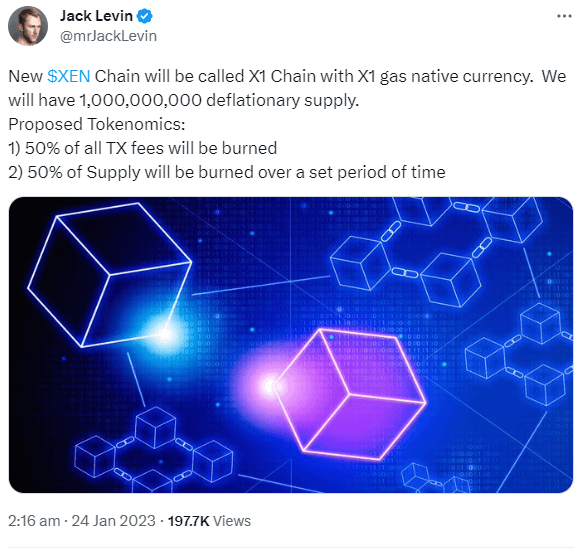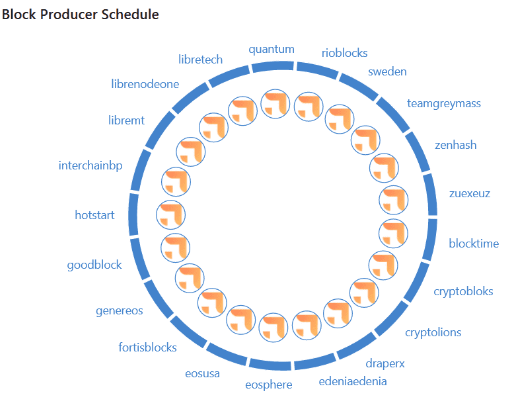Devise fiat
Crypto-monnaies
What is X1 Blockchain? A Solution to Break the Divide between EVM and Bitcoin
Ethereum and Bitcoin are the two most dominant and influential blockchains in the crypto space. Ethereum is the home of smart contracts, decentralized applications, and digital collectibles. Bitcoin is the original and most secure cryptocurrency that serves as a store of value and a medium of exchange. However, Ethereum and Bitcoin are isolated from each other, meaning that users cannot easily swap their tokens or assets across the two chains without relying on third parties or centralized exchanges.
To solve these issues, Jack Levin, the founder of XEN Crypto and a former Google engineer, announced on January 23, 2023 that he is working on a new Layer 1 blockchain called X1. X1 is designed to bridge the gap between the EVM ecosystem and Bitcoin and provide a superior user experience for XEN Crypto. XEN Crypto is a decentralized platform that allows users to create and trade digital collectibles called XENFTs. XENFTs are unique and scarce tokens that represent various forms of art, music, gaming, sports, and more. XEN Crypto has been launched on 10 different blockchains, including Ethereum, Binance Smart Chain, Polygon, Solana, Avalanche, Fantom, Harmony, Heco, OKExChain, and KuCoin Community Chain.

In this article, we will explain how X1 blockchain bridges the gap between EVM and Bitcoin, how it works, and what benefits it will bring to the XEN Crypto ecosystem.
What Is X1 Blockchain?
X1 Blockchain is a First Principles-Based Layer1 Ethereum Virtual Machine (EVM) compatible solution with Bitcoin integration. X1 is going to adopt Delegated Proof of Stake (DPoS) to achieve consensus and produce 1s blocks and 1400 transactions per second. The validators will be able to freely participate upon staking XN tokens and/or securing the required number of votes from the community.
How X1 Blockchain Bridges the Gap Between EVM and Bitcoin?
X1 blockchain bridges the gap between EVM and Bitcoin by using two main components: Polygon Edge's open source zero-knowledge proofs technology and VMPX bridge token.
Polygon Edge is a scaling solution that uses zero-knowledge proofs to compress multiple transactions into groups and relay them to the Ethereum network as a single transaction. Zero-knowledge proofs are a cryptographic technique that allows users to prove that they know some information without revealing it. For example, Alice can prove to Bob that she knows the password to a website without telling him what it is.
By using zero-knowledge proofs, Polygon Edge reduces the gas cost and increases the throughput of the network. According to Levin, X1 will be able to process up to 1000 times faster than Ethereum and have a block time of one second.
VMPX is a fairly-launched BRC-20 token on Bitcoin created by Levin. Its supply is capped at 108,624,000, which is a so-called vampire number. VMPX serves as a bridge token that enables trustless swaps between any BRC-20/Ordinals tokens on Bitcoin and ERC-20/721/1155 tokens on Ethereum or any other EVM-compatible chain.
VMPX uses Libre chain and pNetwork to carry out bridge operations. Libre chain is a sidechain that runs parallel to Bitcoin and uses Delegated Proof of Stake (DPoS) as its consensus mechanism. Libre validators verify the cross-chain asset swaps and aim to guarantee the 1:1 peg with the underlying asset. pNetwork is a decentralized network that connects different blockchains using pTokens. pTokens are ERC-777 tokens that represent 1:1 pegged versions of other assets on different chains.
By using VMPX, users can swap their tokens or assets across different chains without intermediaries or trust. For example, Alice can swap her BRC-20/Ordinals tokens on Bitcoin for Bob's ERC-20/721/1155 tokens on Ethereum using VMPX as a bridge token.

How X1 Blockchain Works
X1 blockchain works as follows:
- Users who have burned their XEN tokens on other chains will be allocated XN coins on X1 according to a predetermined ratio. For example, if Alice burns 1000 XEN tokens on Ethereum, she will receive 1000 XN coins on X1. The total supply of XN coins will be fixed at 10 billion.
- Users can mint, trade, and transfer their XENFTs on X1 with lower fees and higher speed than on other chains.
- Users can access all their XENFTs on one chain without having to switch between different wallets and tokens.
- Users can leverage the combined user base and market cap of all 10 chains and enjoy more exposure and opportunities for their XENFTs.
- Users can connect with the Bitcoin network and swap their BRC-20/Ordinals tokens with ERC-20/721/1155 tokens using the VMPX bridge token.
- Developers can build more advanced features and applications on X1 using Polygon Edge's cutting-edge technology and Aptos's scaling features. Aptos is a scaling solution that uses parallel processing and sharding to improve the performance and security of X1.
What are the benefits of X1 Blockchain?
X1 blockchain will bring many benefits to the XEN Crypto community and ecosystem. Some of them are:
- Faster and cheaper transactions: Users will be able to mint, trade, and transfer their XENFTs on X1 with lower fees and higher speed than on other chains.
- Unified and simplified user experience: Users will be able to access all their XENFTs on one chain without having to switch between different wallets and tokens.
- Increased network effects and liquidity: Users will be able to leverage the combined user base and market cap of all 10 chains and enjoy more exposure and opportunities for their XENFTs.
- Enhanced innovation and development: Developers will be able to build more advanced features and applications on X1 using Polygon Edge's cutting-edge technology and Aptos's scaling features.
- Bridge between EVM ecosystem and Bitcoin: Users will be able to connect with the Bitcoin network and swap their BRC-20/Ordinals tokens with ERC-20/721/1155 tokens using the VMPX bridge token. This will enable more interoperability and collaboration between the two biggest crypto ecosystems.
What Is XN Coin?
XN Coin is the native coin of the X1 Blockchain. XN serves as the backbone of the X1 Blockchain, possessing extensive utility within its ecosystem. The consensus algorithm closely follows the approach of Polygon, utilising the Delegated Proof of Stake (DPOS) mechanism. XN holders can earn rewards by staking their coins or actively participating as Validators and Block Producers, bolstering the network's security and governance mechanisms. X1 Blockchain upholds a fair distribution mechanism for its native gas coin, XN, by completely avoiding any form of preallocation. This approach guarantees equal opportunities for all participants. XN plays a crucial role within the ecosystem, enabling validation, delegation, and staking operations that contribute to the chain's security and consensus.
When will X1 Blockchain launch?
Levin plans to launch the X1 blockchain in the first quarter of 2024. He has already started testing the network on a private testnet and will open it to the public in a few months. The testnet will start as Ethereum's testnet, where users will need to burn their XEN tokens to get X1 testnet tokens. When the testing ends, the testnet will become the mainnet and the X1 testnet tokens will become the mainnet coins.
Before the mainnet launch, Levin will also create a mechanism where anyone who minted XENFTs on any of the 10 chains will get an airdrop of XN coins. This will reward the early adopters and supporters of XEN Crypto and incentivize them to join the X1 network.
Relationship between XN Coin and VMPX BRC-20
The relationship between XN native coin and VMPX BRC-20 is that they are both part of the XEN Crypto ecosystem. XN native coin is the native coin of the X1 Blockchain, which is a Layer 1 solution for XEN Crypto. X1 Blockchain will unite the XEN communities of all 10 chains and provide a fast, secure, and user-friendly environment for creating and trading NFTs.
- XN native coin will be allocated to users who have burned XEN tokens on other chains through a cross-chain relay system. XN native coin will be used as gas for transactions, rewards for validators, and for establishing consensus and security on the X1 Blockchain.
- VMPX BRC-20 is a fungible token standard created on the Bitcoin network with the help of the Ordinals protocol. VMPX BRC-20 was launched by Jack Levin, the founder of XEN Crypto, as part of his adoption and community-building strategy. VMPX BRC-20 has no allocation for founders or venture capitalists, and the community created the entire 108,624,000 supply from scratch.
- VMPX BRC-20 will power the bridge between Bitcoin, Ethereum, and X1 Blockchain, enabling trustless swaps between any BRC-20/Ordinals and ERC-20/721/1155 digital assets. VMPX BRC-20 will also have some utility on the upcoming X1 chain other than scaling Bitcoin itself.
Conclusion
X1 blockchain is an ambitious and innovative project that aims to bridge the gap between the EVM ecosystem and Bitcoin and create a new Layer 1 solution for digital collectibles. By using Polygon Edge's zero-knowledge proofs technology, VMPX bridge token, and Aptos's scaling features, X1 will offer faster and cheaper transactions, unified and simplified user experience, increased network effects and liquidity, and enhanced innovation and development for XEN Crypto. X1 blockchain is set to launch in 2024 and will be a game-changer for the web3 space.
Stay tuned to CoinCarp Social Media and Discuss with Us:
- 9 Costly Mistakes Crypto Holders Make (And How to Avoid Them) Débutant Apr 29, 2025 3m
- Axiym Reaches $132 Million in Volume, Streamlining Global Payments via Avalanche Débutant Apr 24, 2025 2m
- NodeHaus Debuts as Real-Time RPC Monitoring Tool for Blockchain Foundations Débutant Apr 24, 2025 2m
- Hermetica Launches 2.0 Update, Boosting Bitcoin-Backed Stablecoin Transparency and Usability Débutant Apr 23, 2025 2m